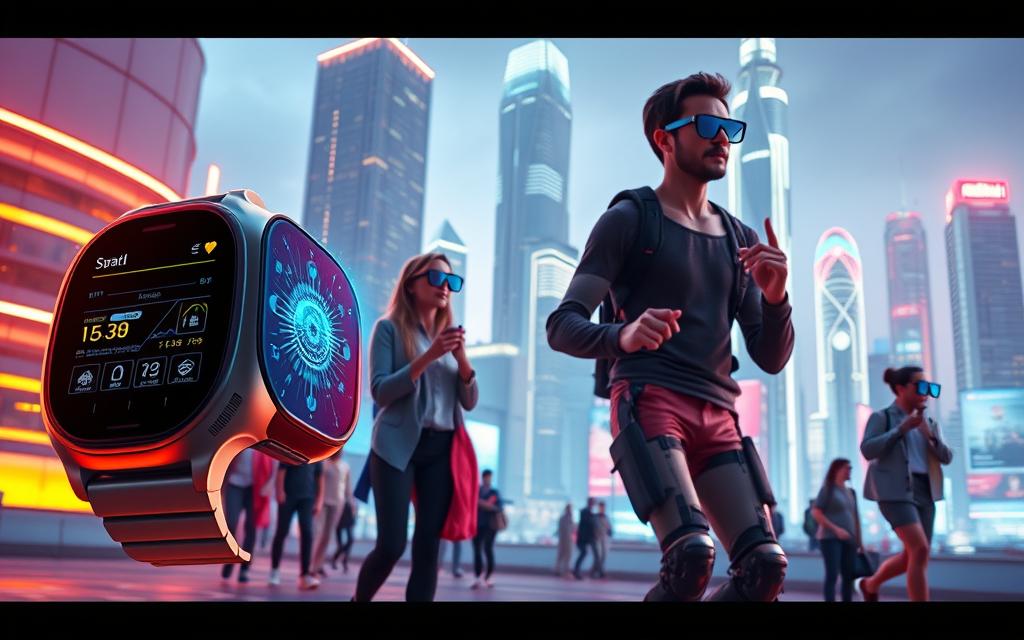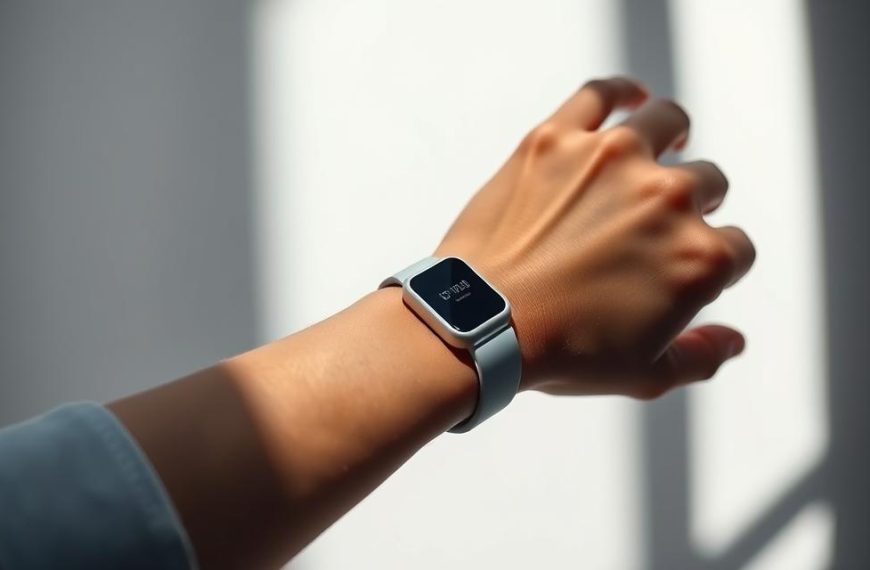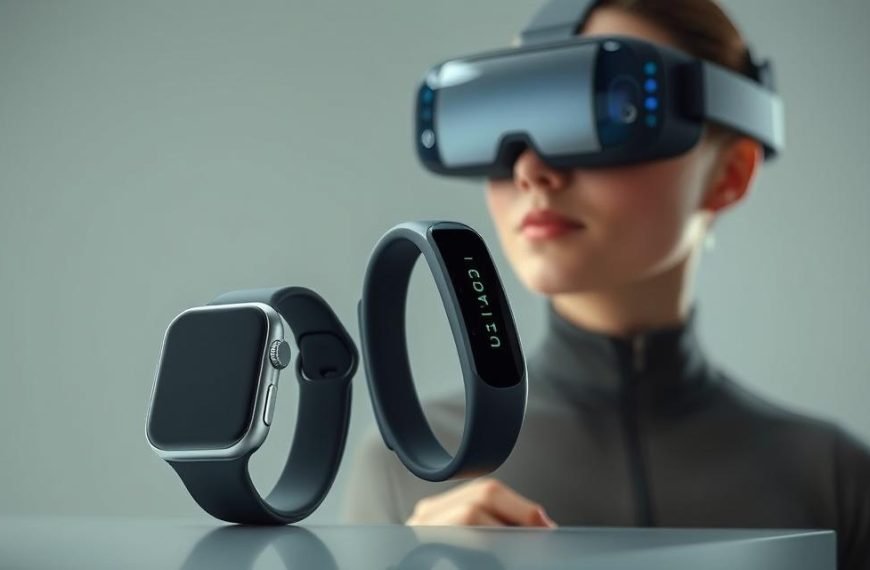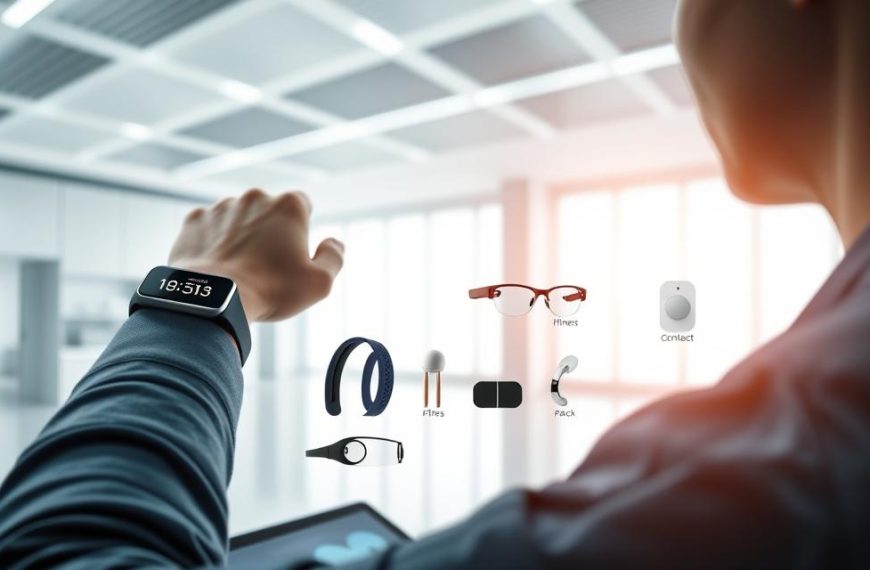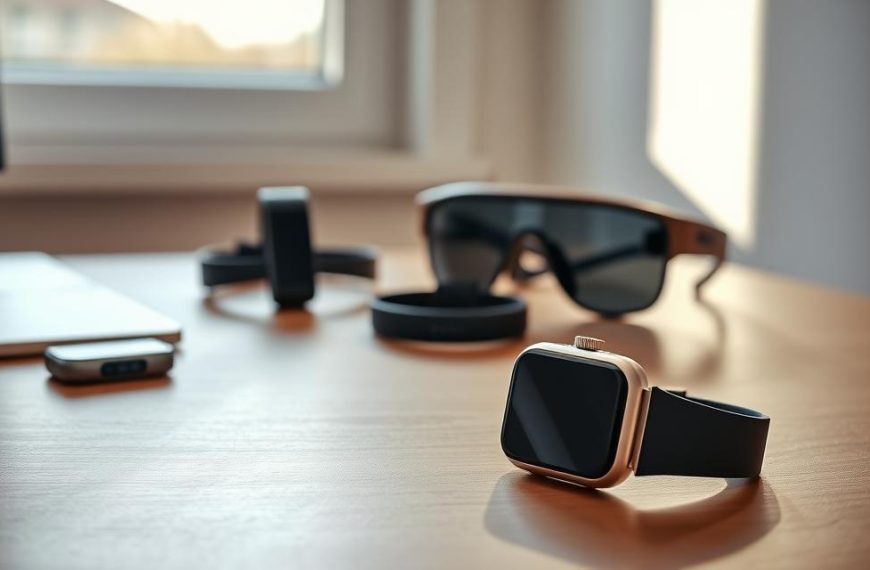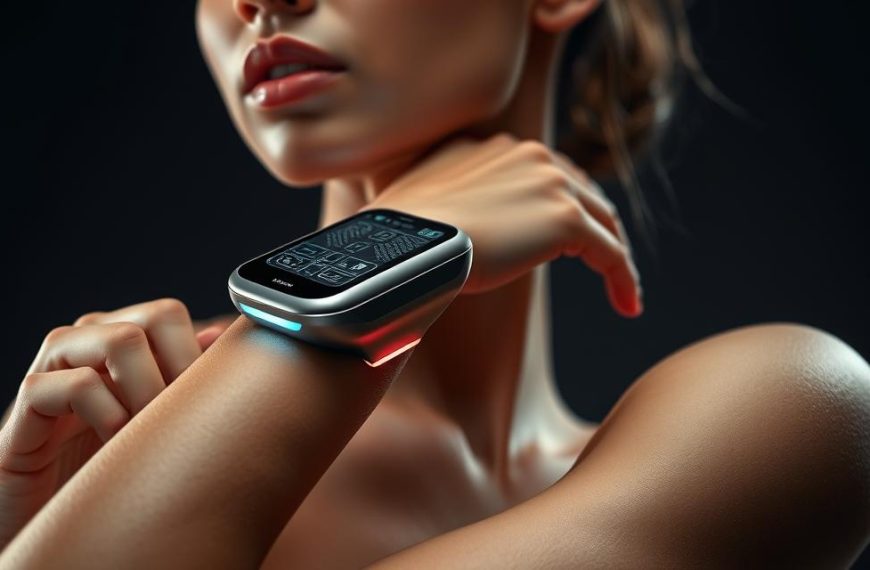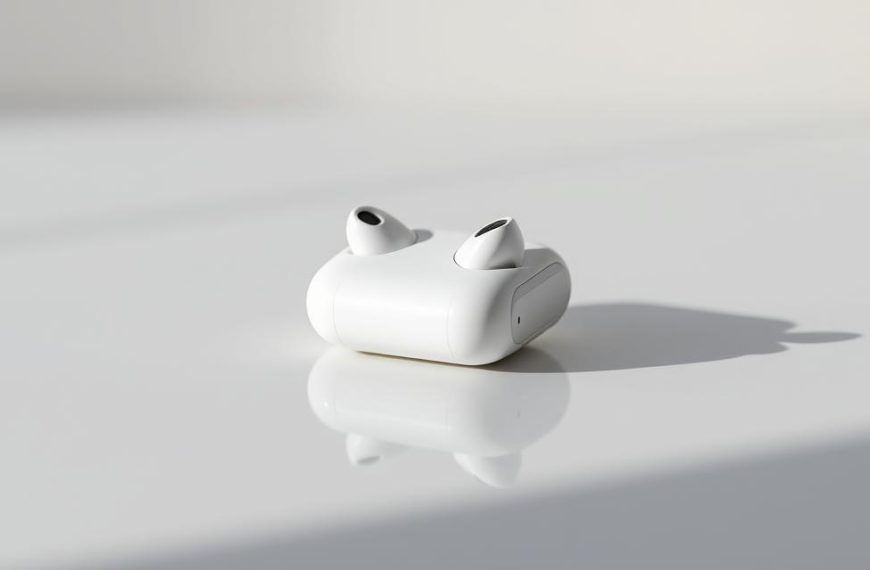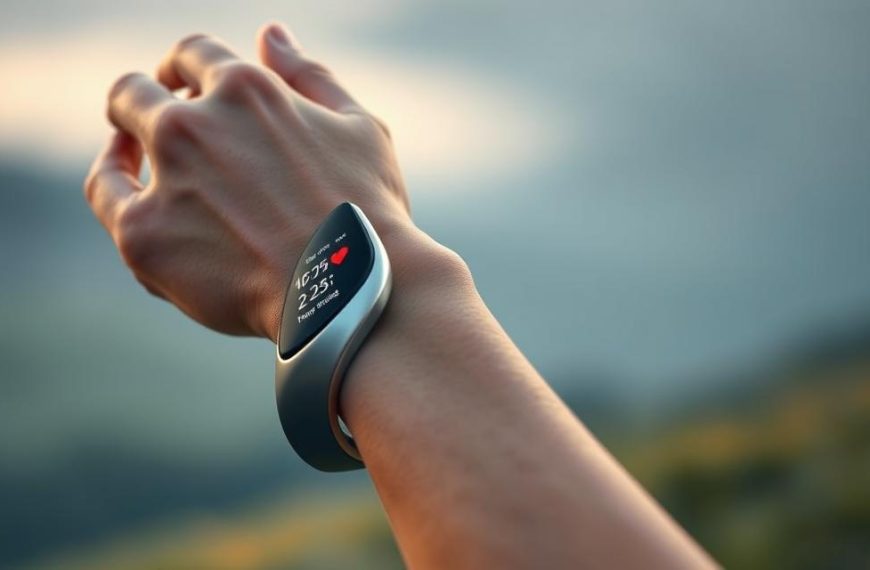Wearables are transforming how we approach health, fitness, and connectivity. From smartwatches to VR glasses, these devices are becoming essential tools in daily life. Market projections show growth from $55 billion in 2022 to $142 billion by 2030, reflecting their increasing popularity.
Advancements in material science are enhancing user experiences. Devices are now more comfortable, durable, and efficient. This progress ensures wearables meet diverse needs, from tracking workouts to monitoring vital signs.
These innovations are reshaping healthcare and digital ecosystems. Wearables provide real-time data, empowering users to make informed decisions. They bridge gaps in fitness, health, and connectivity, creating seamless interactions.
As trends evolve, wearables are poised to play a pivotal role in shaping tomorrow’s world. Their potential to improve lives is undeniable, making them a cornerstone of modern innovation.
Introduction to Wearable Technology
Biometric monitoring systems have become essential in daily routines. These devices seamlessly integrate into our lives, offering real-time insights into health and fitness. From basic fitness trackers to advanced diagnostic tools, their evolution has been remarkable.
Modern devices combine materials science, IoT, and AI to deliver precise results. For example, the Apple Watch includes FDA-approved ECG monitoring capabilities. This convergence has transformed how we approach personal health.
One significant shift is the move from reactive to preventive healthcare models. Sensors in these tools track vital signs, enabling early detection of potential issues. This proactive approach empowers users to take control of their well-being.
Ongoing research continues to drive innovation in this field. The global market for these tools reached $55 billion in 2022, with a projected growth rate of 13.89% through 2030. This growth reflects their increasing importance in modern life.
| Key Advancements | Impact |
|---|---|
| Biometric Monitoring | Real-time health insights |
| FDA-Approved ECG | Enhanced diagnostic accuracy |
| Preventive Healthcare | Early detection of health issues |
These advancements highlight the potential of modern devices to improve lives. By combining cutting-edge technology with user-friendly designs, they are setting new standards in health and fitness.
The Current State of Wearable Technology
Modern tools are revolutionizing health tracking and connectivity. These devices have become essential for monitoring daily activities and vital signs. With advanced features, they cater to diverse needs, from fitness enthusiasts to healthcare professionals.
Market Growth and Statistics
The global market for these devices continues to expand rapidly. In 2022, it was valued at $55 billion, with projections reaching $142 billion by 2030. This growth reflects increasing consumer demand and technological advancements.
Adoption rates are rising across various sectors. Enterprises are integrating tools like RealWear HMT-1 for industrial applications. However, a Stanford study highlights a 23% abandonment rate within six months, indicating challenges in user retention.
Popular Wearable Devices
Leading devices offer a range of innovative features. The Apple Watch Series 8 includes ECG monitoring and fall detection, making it a top choice for health-conscious users. The Oura Ring focuses on sleep staging, providing detailed insights into rest patterns.
Fitbit Charge 5 stands out with its ability to track SpO2, skin temperature, and stress levels using an EDA sensor. These examples showcase the versatility of modern gadgets in addressing diverse health needs.
| Device | Key Features |
|---|---|
| Apple Watch Series 8 | ECG, fall detection |
| Oura Ring | Sleep staging |
| Fitbit Charge 5 | SpO2, skin temperature, stress tracking |
Emerging form factors like Nadi X yoga pants with haptic feedback are pushing boundaries. These innovations highlight the potential for seamless integration into daily routines.
Despite their benefits, adoption barriers remain. High costs and limited functionality for some users contribute to abandonment rates. Addressing these challenges will be crucial for sustained growth.
Advancements in Wearable Technology
Cutting-edge materials are pushing the boundaries of personal devices. These innovations are making tools more efficient, durable, and user-friendly. From flexible displays to advanced sensors, the focus is on enhancing functionality and comfort.
Next-Gen Materials
New materials are transforming how devices are built. For instance, MC10’s BioStamp nCoin uses e-tattoos for concussion monitoring. These ultra-thin biosensors adhere to the skin, providing real-time data without discomfort.
Google’s collaboration with Novartis has led to trials of smart contact lenses for glucose monitoring. These lenses aim to offer non-invasive solutions for diabetes management, showcasing the potential of innovative materials.
Innovative Form Factors
Designs are evolving to meet diverse needs. Samsung’s belt-type devices feature flexible OLED displays, blending style with functionality. These form factors cater to users seeking discreet yet powerful tools.
DSruptive’s SubQ introduces subcutaneous NFC chips for medical ID storage. These implants offer a secure way to access critical health information, though cultural acceptance remains a challenge.
| Innovation | Application |
|---|---|
| BioStamp nCoin | Concussion monitoring |
| Smart Contact Lenses | Glucose monitoring |
| Flexible OLED Displays | Belt-type devices |
| SubQ NFC Chips | Medical ID storage |
Mojo Vision’s smart lens achieves a remarkable 14,000ppi AR display density. This breakthrough highlights the potential for seamless integration of advanced features into compact designs.
As these advancements continue, they promise to redefine how we interact with health tools. The focus remains on creating solutions that are both effective and accessible.
Wearable Technology in Health Monitoring
Health monitoring tools are reshaping how we manage chronic conditions. These devices provide real-time data, enabling better decision-making and improved outcomes. From diabetes to respiratory issues, they are transforming patient care.
Real-Time Health Data
Real-time insights are crucial for effective health management. Devices like Dexcom G7 have shown remarkable results, reducing HbA1c levels by 1.9% in type 1 diabetes patients. This highlights the potential of continuous glucose monitoring in improving patient outcomes.
Closed-loop systems, such as Tandem’s Control-IQ algorithm, automate insulin delivery based on real-time data. These systems minimize manual interventions, ensuring better control over blood sugar levels.
Chronic Disease Management
Managing chronic conditions requires innovative solutions. Remote patient monitoring (RPM) models are gaining traction, with reimbursement policies supporting their adoption. RPM allows healthcare providers to track patients remotely, reducing hospital visits and improving care coordination.
BioIntelliSense’s 30-day patch offers post-operative surveillance, monitoring vital signs continuously. This ensures timely interventions, reducing complications and enhancing recovery.
For respiratory conditions like COPD, Spire Health’s monitoring tools track breathing patterns. This data helps in tailoring treatment plans, improving quality of life for patients.
| Tool | Application | Impact |
|---|---|---|
| Dexcom G7 | Diabetes management | Reduces HbA1c levels |
| Control-IQ Algorithm | Insulin delivery | Automates blood sugar control |
| BioIntelliSense Patch | Post-op surveillance | Monitors vital signs |
| Spire Health | COPD management | Tracks respiratory patterns |
Despite their benefits, data overload remains a challenge in chronic care coordination. Effective strategies are needed to filter and analyze information, ensuring actionable insights for healthcare providers.
Wearable Technology in Fitness
Fitness-focused devices are redefining how users achieve their health goals. These tools provide real-time insights, helping individuals stay active and motivated. From step counting to heart rate monitoring, they offer a comprehensive approach to physical well-being.
Activity Tracking
Activity tracking has become a cornerstone of modern fitness routines. Devices like Fitbit encourage users to take 43% more daily steps compared to non-users, according to JAMA Internal Medicine. This data-driven approach fosters accountability and helps individuals meet their daily targets.
Peloton’s Lanebreak feature incorporates gamification elements, making workouts more engaging. By turning exercise into a game, it boosts motivation and keeps users committed to their fitness journey.
Behavioral Change
Behavioral change is a key benefit of these devices. Apple Watch’s Activity Rings leverage behavioral economics to encourage consistent movement. Completing daily rings creates a sense of accomplishment, driving long-term habits.
Strava’s segment leaderboards introduce social accountability. Users can compare their performance with others, fostering healthy competition and sustained engagement. This community-driven approach enhances motivation and commitment.
Noom integrates wearable data into its weight management programs. By combining activity tracking with personalized coaching, it helps users achieve their health goals effectively.
“The integration of gamification and social accountability in fitness devices has revolutionized how users approach their health.”
| Feature | Impact |
|---|---|
| Fitbit Step Tracking | Encourages 43% more daily steps |
| Apple Watch Activity Rings | Drives behavioral change |
| Strava Leaderboards | Enhances social accountability |
| Noom Integration | Supports weight management |
Despite their benefits, privacy concerns in corporate wellness programs remain a challenge. Employers must ensure data security while promoting employee health. Addressing these issues will be crucial for widespread adoption.
Wearable Technology and Connectivity
Connectivity innovations are reshaping how we interact with digital ecosystems. These advancements bridge gaps between devices, creating seamless user experiences. From IoT integration to immersive environments, the focus is on enhancing interactions and functionality.
IoT Integration
IoT integration is transforming how devices communicate. Meta’s Quest Pro achieves a remarkable 10ms motion-to-photon latency, ensuring smooth transitions in VR environments. This level of responsiveness is crucial for immersive applications, from gaming to professional training.
Disney’s MagicBand+ exemplifies IoT in action. It enhances theme park interactions by syncing with attractions and providing personalized experiences. This seamless connectivity showcases the potential of IoT in everyday life.
Enhanced User Experiences
Innovations like bHaptics’ TactSuit bring haptic feedback to VR, creating a more immersive experience. Users can feel virtual environments, adding a new dimension to digital interactions. This technology is particularly impactful in gaming and simulations.
Nreal Light’s 6DoF tracking elevates mixed reality applications. It allows users to navigate spatial environments with precision, blending the physical and digital worlds. This capability is transforming industries like education and design.
“The integration of haptic feedback and spatial tracking is revolutionizing how we experience digital environments.”
| Innovation | Application |
|---|---|
| Meta Quest Pro | VR with 10ms latency |
| Disney MagicBand+ | Theme park interactions |
| bHaptics TactSuit | Haptic feedback in VR |
| Nreal Light | 6DoF tracking in AR |
Ultrasonic mid-air haptics are pushing boundaries in wearable interfaces. This technology allows users to interact with virtual objects without physical contact, opening new possibilities for user experiences in the metaverse.
Despite these advancements, challenges like motion sickness in VR headset adoption remain. Addressing these issues will be key to unlocking the full potential of connected devices.
Challenges in Wearable Technology
Despite their benefits, these devices face significant hurdles in widespread acceptance. From accuracy concerns to user adoption barriers, addressing these issues is crucial for long-term success.
Accuracy and Reliability
One major challenge is ensuring consistent performance. Variability in sensors and data collection practices can affect results. For instance, overestimation in detection functions may lead to incorrect conclusions, impacting trust in these tools.
Lack of contextual information further complicates data quality assessments. Users need clear insights to make informed decisions, but inconsistent performance can hinder this process.
User Adoption
Adoption rates are influenced by several factors. A Pew Research study found that 41% of users abandon devices due to privacy concerns. Ensuring data security is essential to build confidence.
Comfort also plays a significant role. Devices must balance functionality with wearability to encourage consistent use. Fashion vs. function trade-offs often deter potential users.
Cultural resistance to health data sharing is another barrier. Some individuals hesitate to share personal information, limiting the effectiveness of these tools.
“Addressing privacy and comfort concerns is key to improving adoption rates and building user trust.”
Successful strategies, like Whoop’s subscription model, demonstrate how innovative approaches can enhance user adoption. Offering value beyond hardware helps retain users.
However, the digital divide remains a concern. Elderly populations often face challenges in adopting these tools, highlighting the need for inclusive designs and accessible solutions.
For more insights on these challenges, refer to this detailed analysis.
Future Trends in Wearable Technology
Innovative tools are paving the way for transformative advancements across industries. From healthcare to education, these devices are expanding their reach and functionality. The enterprise wearables market alone is projected to hit $18 billion by 2027, reflecting significant growth and potential.
Emerging Technologies
New developments are reshaping how we interact with devices. For instance, John Hancock’s Vitality program integrates health tracking into life insurance policies, encouraging healthier lifestyles. This approach highlights the growing adoption of tools in the insurance sector.
In education, Muse’s meditation headbands are helping students manage stress and improve focus. These applications demonstrate how tools can enhance learning environments. Similarly, Qwake Technologies’ C-THRU mask is revolutionizing military operations by providing real-time situational awareness.
Market Expansion
The pet wearables market is another area of rapid growth, expected to reach $2.6 billion by 2025. Devices like GPS trackers and health monitors are becoming essential for pet owners. This trend underscores the versatility of tools across diverse industries.
However, regulatory hurdles remain a challenge, particularly in medical device classification. Ensuring compliance while fostering innovation is crucial for sustained market expansion. Addressing these barriers will be key to unlocking the full potential of these tools.
| Industry | Application | Impact |
|---|---|---|
| Insurance | Health tracking | Encourages healthier lifestyles |
| Education | Stress management | Improves focus and learning |
| Military | Situational awareness | Enhances operational efficiency |
| Pet Care | Health monitoring | Ensures pet safety |
As these trends continue to evolve, they will shape the future of tools across various sectors. The focus remains on creating solutions that are both innovative and accessible, driving widespread adoption and market expansion.
Is Wearable Technology the Future?
The integration of advanced devices into daily life is reshaping industries. From fitness tracking to chronic disease management, these tools are proving their potential to transform how we approach health and well-being.
Clinical and consumer adoption metrics highlight their growing impact. For instance, devices like Dexcom G7 have shown significant improvements in diabetes management, reducing HbA1c levels by 1.9%. This demonstrates the healthcare benefits of real-time data collection.
Cost-benefit ratios further support their value. Remote patient monitoring reduces hospital visits, lowering healthcare costs while improving outcomes. This shift towards patient-generated health data empowers individuals to take control of their well-being.
The convergence with 5G and edge computing infrastructure is unlocking new possibilities. Faster data processing and seamless connectivity enhance the functionality of these tools, driving innovation across sectors.
“The ability to collect and analyze real-time health data is revolutionizing how we manage chronic conditions.”
However, standardized validation protocols are critical to ensure accuracy and reliability. Addressing this need will be key to sustaining the transformation these devices bring to healthcare and beyond.
Conclusion
From advanced materials to seamless connectivity, wearables have reached new heights in innovation. Breakthroughs in sensor miniaturization and durable designs have made these tools more effective and user-friendly. Their dual role in preventive healthcare and industrial optimization highlights their versatility.
Cross-industry collaboration will be essential to address challenges and drive further advancements. By 2030, biometric monitoring is expected to become ubiquitous, transforming how we manage health and productivity. This shift will require standardized protocols and inclusive designs to ensure accessibility.
In conclusion, wearables are no longer optional but indispensable tools for modern living. Their ability to enhance care, connectivity, and efficiency positions them as cornerstones of the future. As technology evolves, these devices will continue to shape industries and improve lives.

